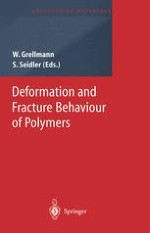
2001 | OriginalPaper | Buchkapitel
Fracture Mechanics Characterization of ABS Materials — Influence of Morphology and Temperature
verfasst von : R. Lach, W. Grellmann, Y. Han, P. Krüger
Erschienen in: Deformation and Fracture Behaviour of Polymers
Verlag: Springer Berlin Heidelberg
Enthalten in: Professional Book Archive
Aktivieren Sie unsere intelligente Suche, um passende Fachinhalte oder Patente zu finden.
Wählen Sie Textabschnitte aus um mit Künstlicher Intelligenz passenden Patente zu finden. powered by
Markieren Sie Textabschnitte, um KI-gestützt weitere passende Inhalte zu finden. powered by
With the growing application field of polymer materials, not only for common but also for technological purposes, the optimization of toughness behaviour, in addition to the improvement of stiffness and strength, has been become a major goal in polymer research [1–4]. The incorporation of a well-dispersed rubber phase into the matrix material has been shown to increase the toughness of glassy amorphous, macroscopically monophase polymers such as SAN or PS that break in an extremely brittle manner [5]. In this connection, ABS materials are an important material group with a broad range of engineering applications [6]. Normally, depending on the particular application, commercial products contain 15–20 wt.% rubber, which corresponds to a balance between toughness, stiffness or strength and price. Depending on the manufacturing process, ABS materials containing rubber particles with an average particle diameter of 0.1–1 μm show the most pronounced influence on toughness behaviour at room temperature (optimum particle size) [7–9]. This observation was verified in [9] by use of a model to estimate the craze volume. Whereas particles with sizes of 0.1–0.5 μm are usually effective in craze initiation, particles < 0.05 μm are not able to initiate crazes [10]. In the case of emulsion-polymerized ABS, the optimum particle size is about 0.3 μm. ABS materials with a multi-modal particle size distribution are often fabricated because other properties besides toughness have a great influence on the overall product quality, for instance hardness, scratch resistance and surface finish. Although ABS materials with broad or multi-modal distributions contain particle fractions that have a lower effectiveness for plastic deformation of the matrix (pp. 335–352), it has been found that their impact resistance is higher than that of materials with narrow distributions [11]. However, the long-time failure behaviour can also be affected negatively (pp. 335–352). ABS materials with a particle diameter of 0.05 μm are scarcely able to dissipate any energy in the impact test, although these materials show a high energy dissipation in the tensile test that is comparable to that of ABS materials with 0.5 μm particles [9].